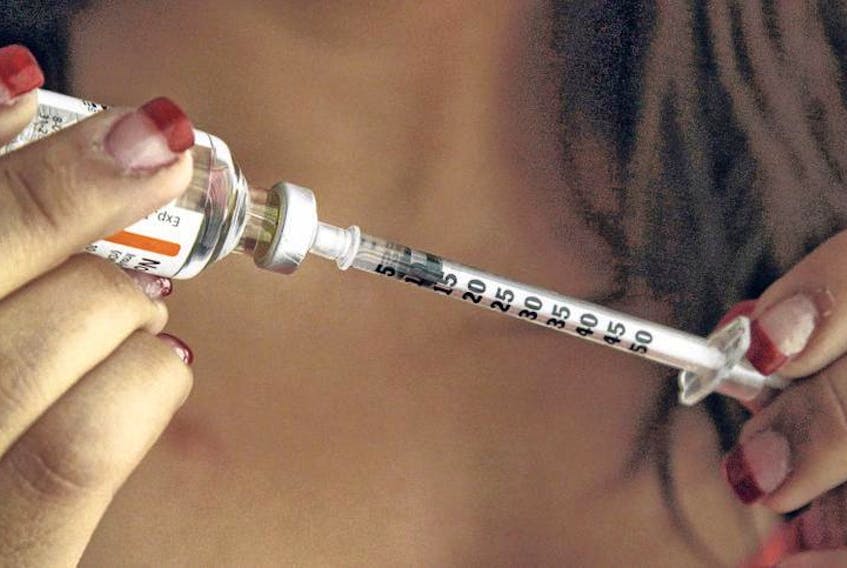Canada must rethink its battle plan in the fight to curb rising diabetes rates, the head of Diabetes Canada says.
“We’re seeing as we watch the diabetes epidemic escalate and escalate, it’s clear what we’re doing now is not working,” said Dr. Jan Hux in an interview Sunday. “If you look at the rates of Type 2 diabetes and obesity in the country, it’s risen dramatically. Genes don’t change that quickly, it’s our environments that have changed, that are really driving obesity and, as a consequence, Type 2 diabetes.”
Those environments include the increasing consumption of unhealthy foods and physical inactivity, Hux said.
Since 2000, the number of people in Canada with diabetes has doubled and today, one in three Canadians lives with diabetes or prediabetes — when your blood sugar is higher than it should be but not high enough to be diabetes.
Hux said a particularly alarming statistic is that Canadians aged 20 have a 50-50 chance of developing Type 2 diabetes (Type 2 is genetically or lifestyle-related, as opposed to Type 1, which is an autoimmune disorder in the same family of diseases such as multiple sclerosis).
At a conference on the weekend in Halifax, Diabetes Canada and the Canadian Society of Endocrinology and Metabolism released an open letter calling on Prime Minister Justin Trudeau and all levels of government to support a national diabetes strategy called Diabetes 360.
The strategy would see the federal government commit $150 million to implement the strategy over the next seven years. Besides government, private industry such as food manufacturers and members of the public should be part of the conversation, Hux said.
Diabetes 360 has the support of groups including the Canadian Medical Association, the Canadian Nurses Association and the Canadian Indigenous Nurses Association (diabetes has been a particular scourge in the aboriginal community where the risk of 20-year-olds getting the disease can reach 80 per cent).
The Diabetes 360 document runs to 43 pages of proposals but the crux of the report focuses on preventing Type 2 diabetes in the first place.
Angie VanKessel, whose son has Type 1 diabetes, said a sea change is needed in how we think about food, which could be sparked through food education starting in school.
That could include learning how to grow your own food, for example, or making it part of your routine to get fruits and vegetables from local growers instead of “eating all this packaged stuff that is unfortunately more affordable than the healthy stuff,” said VanKessel, a horticulturalist who lives near New Glasgow.
She volunteers with Diabetes Canada and attended the weekend conference getting signatures for the open letter to Trudeau calling for action on tackling the disease.
“Our diets have changed so incredibly that we’re seeing this rise and we’re seeing Type 2 in children as well.”
The Diabetes 360 proposals also call for more funding for research into treating Type 1 diabetes. VanKessel’s son Nicholas, eight, was diagnosed when he was two years old.
“Some of the warning signs can be the same as a two-year-old’s attitude — it took a while to figure out — are you cranky or having a tantrum because your blood sugar’s off,” recounted VanKessell, who said the first warning sign was Nicholas refusing food and preferring to drink milk.
Nicholas’s school has assigned a staff member to monitor his health and blood sugar levels, and VanKessel gets detailed information about what he’s eating so she can program his insulin pump.
VanKessel said Nicholas keeps a positive attitude and participates in activities from gymnastics to guitar lessons but she admits it can be challenging when your child must depend on insulin pumps and 24-hour monitoring to stay alive.
“He’s hooked up to all these different machines, which I’m very grateful for but it would be nice to just be free of the insulin,” said VanKessel, whose volunteering includes raising funds for a camp program called D-Camps for children with diabetes.
Canada hasn’t seen a spike in diabetes cases in the last couple of years compared to the dramatic rise in the early 2000s. According to Statistics Canada, seven per cent of Canadians over 12 years of age had diabetes in 2016, which rose to 7.3 per cent in 2017. The 2017 rates were highest in Atlantic Canada with Nova Scotia at 8.6 per cent, Prince Edward Island and Newfoundland and Labrador at 8.9 and New Brunswick with the highest percentage of its population at 9.5.
But Hux said we can’t be complacent about the disease.
“The fact there may be some levelling off is not reason to take a relaxed attitude in terms of taking action,” she said, noting the trend toward younger people at risk of getting the disease. “As Canadians live longer with diabetes, those numbers are going to continue to increase.”









